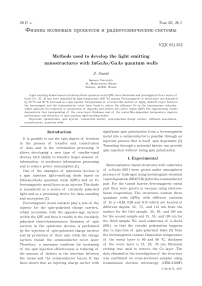Methods used to develop the light emitting nanostructures with InGaAs/GaAs quantum wells
Автор: Saeid S.
Журнал: Физика волновых процессов и радиотехнические системы @journal-pwp
Статья в выпуске: 1 т.20, 2017 года.
Бесплатный доступ
Light-emitting diodes based on InGaAs/GaAs quantum wells (QW) were fabricated and investigated. Cover layers of GaAs (15, 25, 35 nm) were deposited by high temperature (630 ˚C) epitaxy. Ferromagnetic Co metal layer was deposited by 60 ˚C and 90 ˚C and used as a spin injector. Incorporation of a tunnel-thin barrier of Al2O3 dielectric layer between the ferromagnet and the semiconductor cover layer leads to reduce the influence Co on the luminescence intensity, which indicates the reduction of penetration of impurity and defects into active region (QW). The experimental results demonstrate that manipulating of the cover-layer thickness and of the metal-film-deposition temperature improve performance and efficiency of spin injection light-emitting diodes.
Сpolarization, spin injector, tunnel-thin barrier, spin-polarized charge carriers, diffusion penetration, nanostructure, quantum wells
Короткий адрес: https://sciup.org/140255990
IDR: 140255990
Список литературы Methods used to develop the light emitting nanostructures with InGaAs/GaAs quantum wells
- Sarma S.D. Spintronics // Am. Sci. 2001. № 89. P. 516.
- Zutic I., Fabian J., Sarma S.D. Spintronics: Fundamentals and applications // Rev. Mod. Phys. 2004. № 76. P. 323-410.
- Fundamental obstacle for electrical spin injection from a ferromagnetic metal into a diffusive semiconductor / G. Schmidt [et al.] // Phys. Rev. B. 2000. № 62. R4790-R4793.
- Using laser sputtering to obtain semiconductor nanoheterostructure / B.N. Zvonkov [et al.] // J. Opt. Tech. 2008. № 75 (6). P. 389-393.
- Electrical spin injection in forward biased Schottky diodes based on InGaAs-GaAs quantum well heterostructures / N.V. Baidus [et al.] // Appl. Phys. Lett. 2006. V. 89. № 18. P. 181118.


